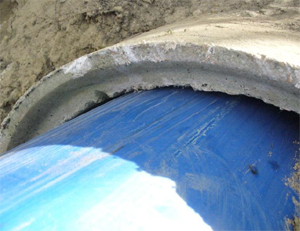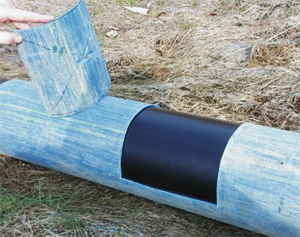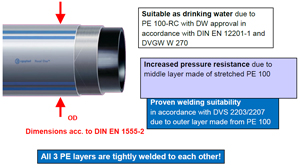Expanded Range of Applications for Plastic Pipes in Water Supply by Using Modern Multi-layer Pipes
August 9, 2012
Today, plastic pipes are also particularly used because they make it possible to save resources and energy. Simply stated: because they make an important contribution to the ecological pillar of sustainability. Alternative installation methods offer these ecological benefits coupled with economic advantages, which is why it is impossible to imagine not using them in pipe construction nowadays.Plastic pipes deliver substantial time-related advantages and have a favorable effect on traffic and noise nuisance. Modern methods run below natural obstacles and make affordable maintenance concepts possible. Polyethylene pipes have been used successfully for the most diverse applications for more than 50 years. In the buried area, polyethylene has clearly prevailed as the material used most frequently for pressure pipe systems. The high degree of flexibility and ductility of polyethylene has made it the No. 1 material for trenchless installation methods. Since polyethylene pipes are very flexible and can be welded with longitudinal force locking, they are heavily used, especially in trenchless pipeline construction. Modern, crack-resistant RC materials (Resistance to Crack) and “clever” multi-layer pipe constructions facilitate their use without increasing the risk to operators.
Applications in the raised pressure area have, until now, been reserved for pipes made from metallic materials. However the use of high-strength reinforcement layers also opens up new application opportunities here for plastic pipes. Fiber-reinforced polyethylene pipes, so-called RTP (Reinforced Thermoplastic Pipes), pursue this objective and have integrated high-strength fibers in the pipe wall made from steel, glass or aramid for example, enabling extremely high operating pressures of even above 100 bar to be achieved. Self-reinforced raised pressure pipes, which are made 100 percent from familiar polyethylene pipe materials such as PE 100 – so-called monocomposites – represent a new approach.
Trenchless Methods Take Over Pipe Construction, but Also Harbor Risks
Trenchless techniques bring with them considerable time-related advantages and have a favorable effect on traffic and noise nuisance. It is possible to pass underneath natural obstacles inexpensively, while rehabilitation and maintenance concepts also benefit from a more favorable financial framework. The high degree of flexibility and evident strength of polyethylene has made this material the No. 1 for trenchless installation methods. It is easy to underestimate the fact that, in contrast to an open installation method where conscious preparations are made beforehand, the trenchless insertion of a pipe places higher demands on the pipe used.
At present there are no legally binding standards setting out detailed technical regulations for pipe selection in the case of alternative installation methods or describing the requirements of the actual installation itself. This places high demands on the expertise of those involved in terms of the selection of materials and procedures, in order to satisfy the generally formulated requirements from applicable laws, directives and ordinances. One of the most common sources of trouble for planners, processing companies and network operators comes from the selection of unsuitable materials or installation methods. The technical rules and regulations require the following as basic principle and objective of planning:
“Buried supply pipelines are of high value. …Therefore a guaranteed minimum service life of 50 years should be asked for when selecting components (pipes, pipework components and fittings). …“ [1]
This basic principle must also apply to new applications and to alternative installation methods.
When it comes to pipeline construction, Paragraph 5.4.2 of the DVGW code of practice GW 321 is of key significance, for example; according to this, an additional outer layer of pipe protection, e.g. polyolefin sheathing, must be used under certain soil conditions. Consequently only pipe systems whose suitability and perfect installation can be indisputably reproduced and documented from a technical point of view may be deployed. Planners, processing companies and network operators are liable where applicable for up to 30 years insofar as the damage has not occurred earlier.
HDD & Pipe Bursting Procedures Place the Highest Demands on the Pipes Used
PE pipe systems have now been in use for more than 50 years. The standardization for PE 100 today assumes a service life of at least 100 years, while the service life assumed by Hessel is even considerably longer [2, 3].
Practical experience has shown that the first generation of PE pipes suffered stress cracks due to local concentrations of stress where bedding faults existed, i.e. to breakages as in the second phase of the creep curve. Today because of this the use of PE pipes in installation instructions, such as the DVGW code of practice W 400 for example, has been restricted to open installation in a sand bed with precise definition of the pipe zone [4].
The new trenchless construction methods have brought about new issues and placed other, greater requirements on the material. Are these requirements safeguarded by improvements in the quality of the raw materials? Do we need to fear other, new failure mechanisms? Are these safeguarded?
Score Protection Through Added Protective Sheathing
In order to meet the growing requirements in pipe construction, egeplast developed the first generation of pipes with protective sheathing in the 1990s [5, 6]. During installation the protective sheathing systematically prevents premature damage to the new pipe so that this can be brought into operation without a reduction in the safety factor (C= 1.25 for drinking water pipes). Since the standardized pipe wall thickness is precisely aligned to the operating pressure – albeit it extended by one safety factor – each weakening means a reduction in the engineering safety factor or, in the case of clear damage, even means a direct reduction in the pressure resistance of the new pipeline and therefore a shortening of the service life.

Figure 1: Weakening of the wall thickness due to grooves created when the pipe was inserted
Where the damage thickness is 20 percent, the wall thickness at this point is reduced which increases the local stress to 10.20 N/mm², i.e. above the permitted stress level. To simplify the calculation, the notch geometry and the impact on the component are not taken into consideration here. The impact on the service life can be read off from the reference characteristic curves in the internal pressure creep test (minimum curves in accordance with DIN 8075) of pipes made from PE 100 [7]. This results in a residual service life of just 23 years. A notch of 24 percent in the wall thickness reduces the time until damage to only 2.5 years (see Figure 2).
Service life in years; Service life 23 years; Depth of damage in %

Figure 2: Service life in relation to the depth of damage in PE 100, SDR 11 according to the reference characteristic curves as set out in DIN 8075 [7]
This approach based on the flat, i.e. ductile phase of the creep curve only applies to the stress crack resistant PE 100-RC materials. An even earlier failure is to be expected from brittle fractures in the case of more notch-sensitive standard qualities of PE 100.
Greatest Reliability for Subsequent Integration
The prerequisite for reliable welding of a PE-HD pipe is a clean, undamaged surface. Especially in the case of electrofusion welding, the damage that occurs to unprotected pipes during insertion harbors a risk. If an attempt is made to plane the grooves away by stripping the scratched and contaminated surface, it is necessary to at least remove the depth of the grooves. This weakens the pressure-bearing wall, while greatly increasing the gap between the pipe and weld coupling. Since one finds an undamaged, clean surface after removing the protective sheathing that protects the pipe during installation, the PE-HD pressure pipe is undamaged and smooth, so that reliable welding is possible after the removal of a minimal layer of oxide film.

Figure 3: Welding on a clean surface after removal of the scratched protective sheathing
One great advantage when using flexible PE pipes is the possibility of squeezing piping. Therefore the media flow can be shut off under pressure for integration and repair measures without the use of shut-off fittings. Cases of damage have been seen in England when PE pipelines were squeezed that had previously been installed using trenchless methods and which had surface grooves [8].

Figure 4: a) Splitting during the squeezing of a scratched PE 100-RC pipe b) Squeezing after removal of the protective sheathing of an SLM RCplus pipe
By contrast, when using pipes with protective sheathing, the notches triggering the cracks are systematically prevented, so that the pipeline can be squeezed without risk.
Recommendation for the Safe Use of Alternative Installation Methods
The requirements relating to pipe systems with protective sheathing that are recommended for trenchless installation are set out in the industry standard PAS 1075 “Polyethylene Pipes for alternative installation techniques – dimensions, technical requirements and testing” [9]. This industry standard defines a quality standard that can be verified by independent certification.
The requirements described go significantly beyond those properties prescribed in the DIN EN standards and in the DVGW rules and regulations for pipes installed using trench techniques, and also guarantee a service life of at least 100 years for alternative installation methods.
PAS 1075 groups the pipe systems available on the market into three types independently of manufacturer, thereby making it possible for the user to differentiate between pipe designs in accordance with practical requirements.
Type 1 Solid walled pipes made from PE 100-RC; Type 2 Pipes with dimensionally integrated layers made from PE 100-RC; Type 3 Pipes made from PE 100-RC with additional outer protective sheathing

Figure 5: The pipe constructions described in PAS 1075
Only pipes with added protective sheathing (Type 3 in PAS 1075) satisfy all requirements and should consequently be used in “black box” installations with a closed installation method.
Multi-Layer Plastic Pipes for Raised Pressure Applications
In order to be able to deploy the positive qualities of polyethylene in the raised pressure area, it is necessary to integrate high strength materials in the pipe wall as reinforcement because the material is less strong than metal. Fiber reinforced polyethylene pipes, so-called RTP (Reinforced Thermoplastic Pipes), pursue this objective and have integrated high-strength fibers in the pipe wall made from steel, glass or aramid for example, enabling extremely high operating pressures of even above 100 bar to be achieved [11].

Figure 6: HexelOne is a raised pressure PE pipe made from “homogeneous materials” and with 3 functional layers
The strength of polyethylene can be significantly increased by stretching the original material and the associated targeted microstructure optimization during processing. If the resulting high-strength structures from one and the same material are specifically utilized to reinforce a component, then this is referred to as self-reinforcement or monocomposites. The advantage of such polyethylene monocomposites is that other positive qualities, such as good weldability, low specific gravity and flexibility, are almost unimpaired by the consequent multilayer structure (integration of the reinforcement layer made from stretched polyethylene). A further benefit of the homogeneous material i.e. pure HexelOne pipes, is the possibility to recycle left-over pieces of pipe material.
This article was submitted by egeplast Werner Strumann GmbH & Co. KG, Greven, Germany.
Bibliography:
[1] DVGW Code of Practice W 400 “Technical regulations for water distribution plants, Part 1: Planning”, 2004
[2] DIN 8074: “Polyethylene Pipes (PE); PE 63, PE 80, PE 100, PE-HD pipe dimensions”, 1999
[3] Hessel, J.: “100 Jahre Nutzungsdauer von Rohren aus Polyethylen“,
3R international (46) Heft 4/2007
[4] DVGW Code of Practice W 400 “Technical regulations for water distribution plants, Part 2: Construction and testing”, 2004
[5] Schröder, G.: “Safety-Line – Die neue Generation von PE-HD-Rohrleitungen” bbr 4/1995
[6] Wolter R.: “Flexibel und doch widerstandsfähig”, gwf (140) S. 130-131, 1999
[7] DIN 8075: “Polyethylene pipes (PE); PE 63, PE 80, PE 100, PE-HD – General quality requirements, testing “, 1999
[8] Derek Muckle: “Understanding, then avoiding in-service failures linked to the use of the squeeze-off flow stopping technique”, Plastic Pipes Conference Vancouver, 2010
[9] PAS 1075 “Polyethylene pipes for alternative installation techniques – dimensions, technical requirements and testing”, Beuth Verlag (Ref. No. PAS 1075: 2009-04)
[10] M. Veenker: Kunststoffleitungen im Hochdruckbereich, 3R international (40) Heft 4/2001



